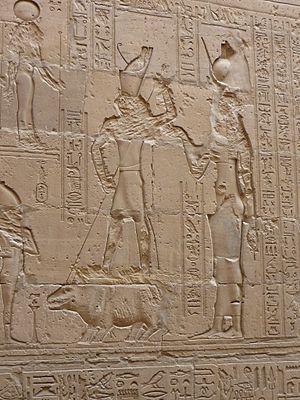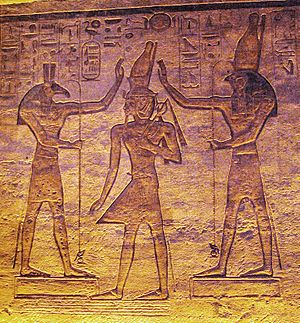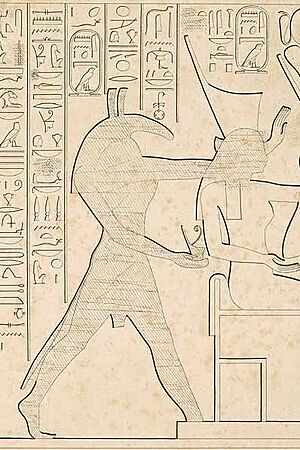Set (deity) facts for kids
Quick facts for kids Set |
|
|---|---|
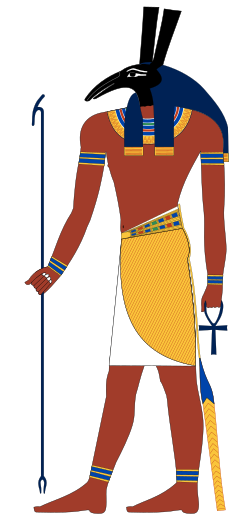 |
|
| Major cult center | Ombos, Avaris, Sepermeru |
| Symbol | Was-sceptre, Set animal |
| Personal information | |
| Consort | Nephthys, Neith, Anat, and Astarte |
| Offspring | Anubis, Wepwawet, Sobek and Maga |
| Parents | Geb, Nut |
| Siblings | Osiris, Isis, Nephthys, Horus the Elder |
| Equivalents | |
| Greek equivalent | Typhon |
Set was an important god in ancient Egyptian religion. He was known as the god of deserts, storms, and disorder. He also represented foreigners and violence.
Set was the lord of the Red Land, which was the desert. This was different from Horus, who was the lord of the Black Land, the fertile land along the Nile River.
In the famous Osiris myth, Set is shown as the brother who murdered Osiris. Osiris's wife, Isis, brought him back to life with the help of the goddess Nephthys. Isis then had a son named Horus. Horus wanted revenge on Set. Many ancient Egyptian stories tell about their battles. Set is also linked to the Sahara Desert, west of the Nile.
Contents
Set's Family Tree
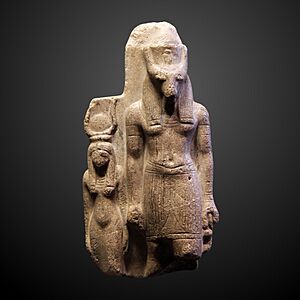
Set was the son of Geb, the Earth god, and Nut, the Sky goddess. His brothers and sisters were Osiris, Isis, Horus the Elder, and Nephthys.
Set married Nephthys. They had two children, Anubis and Wepwawet. Some stories say Set also had relationships with foreign goddesses named Anat and Astarte. From these, a crocodile god named Maga was born.
The Mysterious Set Animal
In ancient Egyptian art, Set was often shown as a special creature. This creature is called the Set animal. No one knows exactly what animal it was based on.
People have guessed it might look like an aardvark, an African wild dog, a donkey, or even a fennec fox. The Set animal has a snout that curves downwards. It has long ears with flat ends and a thin, forked tail. Its body is slender, like a dog.
Sometimes, Set was shown as a human with the head of this unique animal. Later, during the Late Period, Set was often shown as a donkey or a man with a donkey's head.
The oldest pictures of what might be the Set animal come from a tomb built around 3790–3500 BCE. Another early image is on a special club called a ceremonial mace. This mace belonged to an ancient ruler named Scorpion II.
Horus and Set: A Great Rivalry
A very important part of Set's story is his fight with Horus. Horus was either Set's brother or his nephew. They fought over who should be the king of Egypt.
Their conflict was often violent. But it was also like a court case. A group of Egyptian gods called the Ennead would decide who should rule. The judge was often Geb, who was the father of Osiris and Set. Sometimes, the creator gods Ra or Atum were the judges.
The stories of Horus and Set's rivalry are told in two ways. In some tales, Horus is Osiris's son and Set's nephew. Osiris's murder is the main reason for their fight. In other stories, Horus and Set are brothers. These different versions appear in many ancient texts.
The divine struggle had many parts. The two gods asked other deities to help them settle the dispute. They also competed in different challenges. For example, they raced in boats or fought as hippopotami. Most gods supported Horus, and he often won these contests.
However, the dispute lasted for eighty years! This was mainly because the creator god, who was the judge, favored Set. In some later texts, the conflict is described as a huge battle involving all their followers.
In one famous part of the story, Set harms or tears out one or both of Horus's eyes. Sometimes, the eye is even torn into pieces. This event is very important. Horus was a sky god, and his right eye was the sun, while his left eye was the moon. So, when his eye was damaged, it represented the moon getting dark during its phases or during an eclipse.
Horus might get his eye back himself. Or other gods like Isis, Thoth, or Hathor might help him. They would either find it or heal it. When Horus's eye was restored, it meant the moon became bright again. It also meant Horus got the kingship back.
Set: Protector of the Sun God Ra
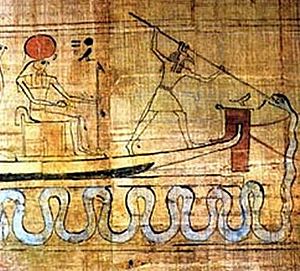
Set also had a good side. He was shown standing at the front of Ra's boat. Ra was the sun god. Set's job was to defeat the evil serpent Apep, who tried to stop Ra's journey through the underworld.
In some later pictures, Set is shown with a falcon's head in this role. This made him look like Horus. In an ancient text called the Amduat, Set is described as being very important in defeating Apep.
Set's Changing Role in History
During a time called the Second Intermediate Period (1650–1550 BCE), a group of foreign people called the Hyksos ruled parts of Egypt. They chose Set as their main god. This was because Set was originally a chief god of Upper Egypt and was also the god of foreigners. They found him similar to their own chief god, Hadad.
When the Egyptians, led by Ahmose I, drove out the Hyksos, people's feelings towards foreigners changed. But Set's worship continued to be strong in some areas. The family of Ramesses I, who started the Nineteenth Dynasty, had strong connections to Set's priests.
Set also became linked with foreign gods during the New Kingdom. Egyptians connected him with the Hittite storm god Teshub and the Canaanite god Baal. They were sometimes worshipped together as "Seth-Baal."
Why Set Was Seen as Evil Later On
Set's image became more negative after Egypt was conquered by several foreign nations. This happened during the Third Intermediate and Late Periods. Since Set was the god of foreigners, he became linked to these foreign rulers who oppressed Egypt.
During this time, Set was strongly disliked. His defeat by Horus was celebrated even more. People focused on Set's negative qualities during this period.
Places Where Set Was Worshipped
Set was worshipped in several temples. Some of these were in places like Ombos and Oxyrhynchus in Upper Egypt. He was also worshipped in parts of the Fayyum area.
A very important temple for Set was in a town called Sepermeru, especially during the time of the Ramesses pharaohs. This temple was known as the "House of Seth, Lord of Sepermeru." Sepermeru was called the "gateway to the desert," which fit Set's role as a desert god.
Set's worship continued even in the later days of ancient Egyptian religion. This happened in important but faraway places like Kharga and Dakhlah. In these places, Set was called "Lord of the Oasis / Town." His wife, Nephthys, was also honored as "Mistress of the Oasis" alongside him in his temples.
Interesting Facts About Set
- In Ancient Greek, Set's name was Sēth.
- In ancient Egyptian astronomy, Set was often connected with the planet Mercury.
- Set is sometimes linked to a smaller god named Ha. Ha was the god of the desert and was shown as a man with a desert symbol on his head.
- Several Egyptian kings were named after Set. Two famous ones are Seti I (meaning "man of Set") and Setnakht (meaning "Set is strong").
See also
 In Spanish: Seth para niños
In Spanish: Seth para niños




